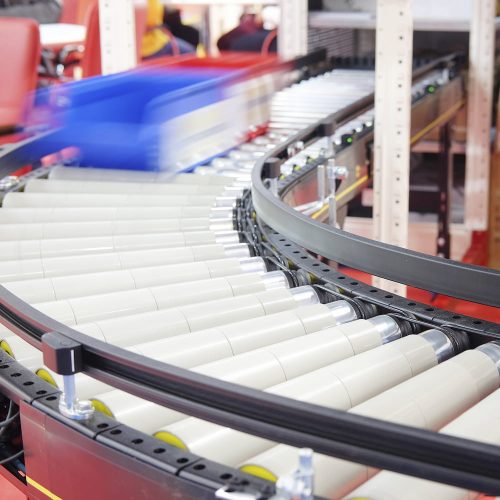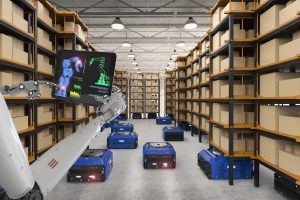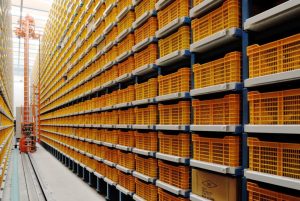In the latest instalment of BoxLogic’s Warehouse Automation series Rob Palin, Senior Consultant, investigates the Warehouse Mechanisation.
In this post, Rob provides an overview of the key MHE (Material Handling Equipment) used in mechanised solutions, outlines where it can be used in the warehouse and why businesses opt to mechanise instead of automate.

Introduction to Warehouse Mechanisation
Warehouse Mechanisation is the implementation of simple technology that assists people with tasks that would otherwise require low-skilled manual labour.
It doesn’t usually require much, if any, integration and is often ‘dumb’, performing a single task with little to no logic, supported by people. Such examples might include conveyors or lifts to move products between two points and pick to light systems to support a bulk pick and out-sort process.
Conveyors
Warehouse conveyors can be an excellent way of reducing cost from an operation by minimising human movement. The primary purpose of a conveyor is to move material between two points; but when combined with other processes the benefit can be compounded. For example, the use of conveyors to move inbound product from a container to feed a palletising robot; or using conveyors to feed a Carton Live Pick Tower.
There are many types of conveyors available to be used in a variety of use cases. The Top commonly deployed conveyors are listed below:
Conveyor Type | Description |
|---|---|
Belt Conveyor | The most common type of conveyor (picture a supermarket checkout conveyor). A motor is used to turn a series of pulleys which in turn moves the conveyor belt. |
Gravity Roller Conveyor | Rather than using a powered belt, this conveyor uses cylindrical rollers built on a slight decline allowing product to roll freely along the conveyor. |
Powered Roller Conveyor | Much like gravity rollers this conveyor uses cylindrical rollers, however they are driven by a chain or belt. They do not have to be built on a decline and can sometimes even go uphill. |
When designing a warehouse conveyor system, an important consideration is which processes are better suited to mobile conveyor systems, and which processes would require a static solution.
Mobile Conveyors
Mobile conveyors are generally gravity roller systems, which have skatewheel attachments. Each leg has a small wheel attached to the bottom which allows operatives to push and reposition the conveyor. They can also be built with extendable scissor beds meaning they can be extended when required or retracted for storage. This makes them an ideal solution for short intermittent processes such as loading/unloading a vehicle.

Static Conveyors
Whilst static conveyors can be reconfigured at a later date, they are best suited to longer term deployments. They can be used at a variety of scales from mechanising a single process, through to large scale, where the entire warehouse is designed around a conveyor system.
Static conveyors can provide the largest benefit when combined with other processes or technologies. Using conveyors as part of a zone-pick system for example, can allow for complex product routing around a warehouse by using sensors to identify products and directing them to specific warehouse locations. Another common example is the use of telescopic boom conveyors, which extend into the back of containers and trailers to minimise the amount of movement operatives are required to perform when destuffing containers.
Whilst mechanising a single process with conveyors can be relatively simple, a thorough design process should be followed when considering a large-scale conveyor implementation.
Pick to Light Systems
Pick to Light (or PTL) is an order picking technology that utilises lights on racks or shelves to indicate pick locations and guide operatives to the correct location. The system can be as simple as a single light on the destination location or could be more complex, with a small LED screen at each location displaying the qty to be picked.
Pick to Light can provide an operation with increased pick rates, as well as increased picking accuracy by reducing human error. These are achieved by moving from order picking to a batch pick and outsort process; thereby visiting each stock location only once, instead of for each order. Pick to Light is commonly used in fresh operations as part of a ‘pick to grid’ process, where no pickface exist due to the shelf life of the product. It is best suited to operations where the same SKU or SKUs are picked over many orders.
Where can Mechanisation be used?
With so many available solutions, mechanisation can be deployed across a large majority of warehouse processes.
Warehouse Process | Mechanisation Scenarios |
|---|---|
Inbound | A boom conveyor is used to unload a container, feeding a palletising robot. Pallets are output to a mechanised shrink-wrapper. |
Storage and Replenishment | A conveyor system is used to putaway products to carton live shelving. AGVs are used to transport pallets to bulk storage where they are then putaway into dynamic racking. |
Sorting and Marshalling | Sortation conveyors to move outbound product to their relevant despatch bays. |
Despatch | Palletising robots can stack product ready for despatch before a shrink wrapper completes the pallet. |
Why Mechanise Versus Automate?
Full automation implementations can often be cost prohibitive for many operations, as lower throughput volumes make it difficult to receive return on investment within a reasonable time frame. For others, current infrastructure such as immovable mezzanines, or non-standard processes, can mean that full automation is simply not possible.
In these circumstances Warehouse Mechanisation can provide a viable middle-ground between a traditional physical operation and full warehouse automation.
Summary
Conveyor systems offer a much more efficient way of transporting product around a warehouse, even more so when combined with other technologies. Once product has reached its correct location, systems like Pick to Light can help to increase both the efficiency and accuracy of a picking process.
If you need advice on the best mechanisation technologies to use, or help in designing your next warehouse, then get in touch with our warehouse consultants to find out how we can help you to design an efficient automated operation in your distribution facility.



